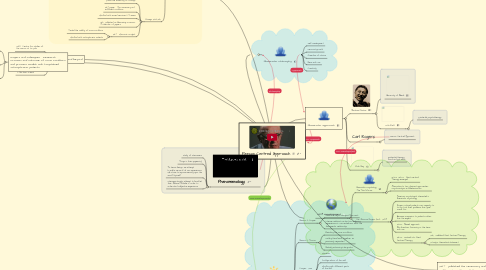
1. California and beyond
1.1. 1968 - Centre for Studies of the Person at La Jolla
1.2. Encounter groups and cross cultural workshops
1.3. Person-Centred Approach
1.4. Peace work in South Africa & Northern Ireland
2. Rogers and colleagues - Research Process and outcome of core conditions and process models with hospitalised schizophrenic patients
2.1. No significant effect found
2.2. Concluded that the empathic, reflective approach is not effective for clients 'locked in their own world'
2.3. Schizophrenic clients require the therapist to take risks in being open, honest and self-disclosing with an emphasis on congruence
3. Humanistic Philosophy
3.1. Self Development
3.2. Personal growth
3.3. Freedom of choice
3.4. Here and now
3.5. Creativity
4. Phenomenology
4.1. Study of Phenomena
4.2. "Things in their appearing"
4.3. "As human beings, we attempt to make sense of all our experiences We strive to impose meaning upon the world" (Spinelli)
4.4. Phenomenologists attempt to bracket their 'Natural Attitude' in order to understand subjective experience
5. Influences
5.1. Rochester 1928-1940
5.1.1. 1928 - Worked as a psychologist at the Child Study Department with children, parents and families
5.1.2. Strong influence on PCA after 10 years experience in the field
5.1.3. 1939 - published 'The clinical Treatment of the Problem Child'
5.1.3.1. Emerging PCA approach - "dealing with the child, not with the behaviour symptoms.
5.2. Ohio 1940-1945
5.2.1. 1940 - began teaching
5.2.2. Rogers and students studied the efficacy of 'directive' & 'non-directive' counselling.
5.2.3. Challenged the therapist as expert
5.2.4. Studied recordings and transcripts of sessions
5.2.5. PCA theory beginning to emerge - Presented a talk titled - 'New Concepts in Psychotherapy'
5.3. Chicago 1945-1961
5.3.1. Joined the University of Chicago
5.3.2. 1957 paper - 'The necessary and sufficient conditions'
5.3.3. Worked with armed services & Trauma
5.3.4. 1961 - Published 'On Becoming a Person' A collection of papers
5.3.5. 1957 - Wisconsin Project
5.3.5.1. Tested the 'validity' of core conditions
5.3.5.2. Worked with Schizophrenic Patients
6. New Developments
6.1. Mearns & Cooper
6.1.1. Relational Depth Dialogical Approach
6.1.2. Intense relational contact and enduring experiences in connectedness within the therapeutic relationship
6.2. Mearns & Thorne
6.2.1. Revisiting the core conditions
6.2.2. 'Putting them back together' as previously separated
6.2.3. Mutually enhancing intergration
6.3. Cooper - 1999
6.3.1. Pluralism
6.3.2. Configurations of the self
6.3.3. Working with different parts of the self
6.3.4. Argued that Rogers description of Self is unidimensional based on Rogers' observation of 'violent fluctuations in the concept of self' (Rogers, 1959, p.201)
6.4. Prouty - 1994
6.4.1. Pre Therapy
6.4.2. Allows clients to connect with the physical and social world
6.4.3. Clients with severe autism or schizophrenia
6.5. Rogers and Natiello
6.5.1. Person Centred Expressive Art Therapies
6.5.2. Useful for children, young people & people in crisis
6.6. Merry
6.6.1. current practitioner and writer
6.7. Sanders
6.7.1. current practitioner and writer
7. 1957 - published the necessary and sufficient conditions of therapeutic personality change
7.1. Conditions required for therapeutic change in any relationship-based approach to counselling
8. Humanistic approach
8.1. Abraham Maslow
8.1.1. Hierarchy of Needs
8.1.2. Otto Rank
8.1.2.1. Existential psychotherapy
8.2. Carl Rogers
8.2.1. Person Centred Approach
8.3. Rollo May
8.3.1. Existential therapy Good and Evil within
9. PCA Development
9.1. Humanistic Psychology 'The Third Force'
9.1.1. 1940's -1950's - Client centred Therapy emerged
9.1.2. Alternative to two dominant approaches - Psychoanalysis and Behaviourism
9.2. Carl Ransom Rogers (1902 - 1987)
9.2.1. American Psychologist interested in Humanistic Psychology
9.2.2. Rogers noticed patients own capacity to to sort out their problems than given credit for
9.2.3. Became companion to patients rather than the expert
9.2.4. 1940's - Named approach Non-directive, focussing on the 'here and now'
9.2.5. 1950's - evolved into 'Client Centred Therapy'
9.2.5.1. 1951 - Published Client Centred Therapy
9.2.5.2. 1st major theoretical statement
